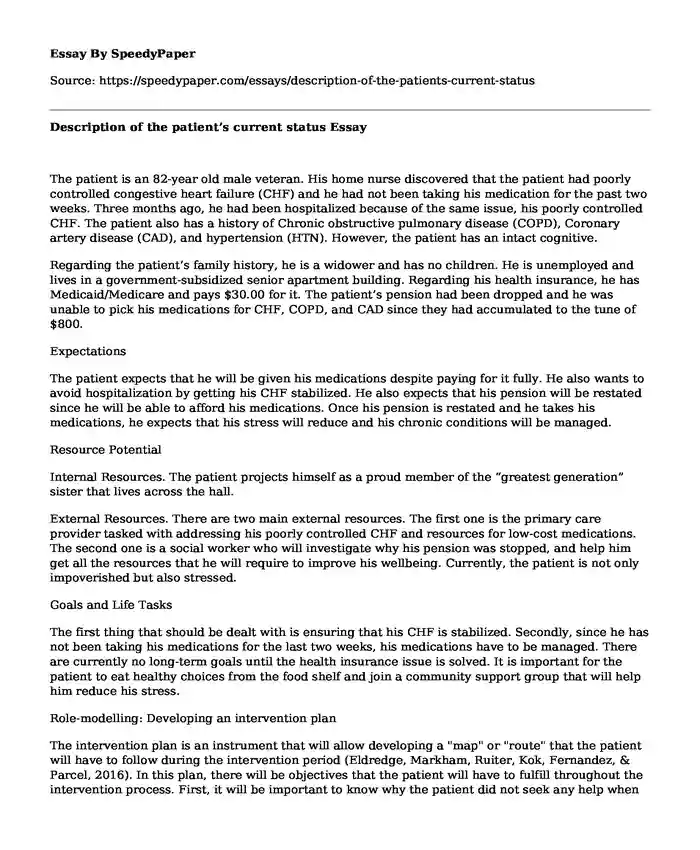
| Type of paper: | Case study |
| Categories: | Psychology Literature Medicine |
| Pages: | 4 |
| Wordcount: | 829 words |
The patient is an 82-year old male veteran. His home nurse discovered that the patient had poorly controlled congestive heart failure (CHF) and he had not been taking his medication for the past two weeks. Three months ago, he had been hospitalized because of the same issue, his poorly controlled CHF. The patient also has a history of Chronic obstructive pulmonary disease (COPD), Coronary artery disease (CAD), and hypertension (HTN). However, the patient has an intact cognitive.
Regarding the patient's family history, he is a widower and has no children. He is unemployed and lives in a government-subsidized senior apartment building. Regarding his health insurance, he has Medicaid/Medicare and pays $30.00 for it. The patient's pension had been dropped and he was unable to pick his medications for CHF, COPD, and CAD since they had accumulated to the tune of $800.
Expectations
The patient expects that he will be given his medications despite paying for it fully. He also wants to avoid hospitalization by getting his CHF stabilized. He also expects that his pension will be restated since he will be able to afford his medications. Once his pension is restated and he takes his medications, he expects that his stress will reduce and his chronic conditions will be managed.
Resource Potential
Internal Resources. The patient projects himself as a proud member of the "greatest generation" sister that lives across the hall.
External Resources. There are two main external resources. The first one is the primary care provider tasked with addressing his poorly controlled CHF and resources for low-cost medications. The second one is a social worker who will investigate why his pension was stopped, and help him get all the resources that he will require to improve his wellbeing. Currently, the patient is not only impoverished but also stressed.
Goals and Life Tasks
The first thing that should be dealt with is ensuring that his CHF is stabilized. Secondly, since he has not been taking his medications for the last two weeks, his medications have to be managed. There are currently no long-term goals until the health insurance issue is solved. It is important for the patient to eat healthy choices from the food shelf and join a community support group that will help him reduce his stress.
Role-modelling: Developing an intervention plan
The intervention plan is an instrument that will allow developing a "map" or "route" that the patient will have to follow during the intervention period (Eldredge, Markham, Ruiter, Kok, Fernandez, & Parcel, 2016). In this plan, there will be objectives that the patient will have to fulfill throughout the intervention process. First, it will be important to know why the patient did not seek any help when he found out about the price of the medication. Secondly, it will be important to discuss with the patient his lack of effective coping skills. Lastly, a discussion concerning the patient's CHF symptoms will be important and a plan of care established and managed effectively. The plan will be based on medication intake, food intake, and exercise.
Aims of intervention
The intervention plan will have three main objectives. The first one will be to establish a trust provider-patient relationship. Secondly, the plan will help in identifying, expressing, and processing any negative emotions. Thirdly, the plan aims at promoting mind-body awareness through good night sleep, healthy food choices, light, and meditation and relaxation techniques such as deep breathing, walking, prayers, and reaching out to those who are a positive influence on his life.
Congestive Heart Failure
The first step will involve discussing pharmacological and non-pharmacological treatments. The patient will have to take medications as prescribed, cut back on salt, visit primary care provider (PCP) twice every month to check on his weight and blood pressure. The patient should monitor any worsening symptoms caused by CHF, and maintain fluid balance.
Health Promotion
There are several health promotion strategies that will be useful to the patient. Community support will be helpful in managing his stress (Varvogli & Darviri, 2011). Visiting a PCP constantly will ensure that the CHF situation does not reach critical levels without being addressed. The patient will have to eat healthy foods. Lastly, it will be important to establish why the patient was not reaching out to his PCP and address the problem.
Outcomes
His pension is reinstated by the Veteran's Administration and the patient accepts to reach out to his PCP for CHF management, health coverage issues, and inform his PCP of any stopped medication due to any financial or stressful circumstances. Lastly, the patient accepts the proposed stress management techniques.
The patient understood his plan of care and left the PCP feeling happy and satisfied. He was happy that his concerns had been addressed by the PCP.
References
Eldredge, L. K. B., Markham, C. M., Ruiter, R. A., Kok, G., Fernandez, M. E., & Parcel, G. S. (2016). Planning health promotion programs: an intervention mapping approach. John Wiley & Sons.
Varvogli, L., & Darviri, C. (2011). Stress Management Techniques: evidence-based procedures that reduce stress and promote health. Health Science Journal, 5(2), 74.
Cite this page
Description of the patient's current status. (2022, Nov 08). Retrieved from https://speedypaper.com/essays/description-of-the-patients-current-status
Request Removal
If you are the original author of this essay and no longer wish to have it published on the SpeedyPaper website, please click below to request its removal:
- Scholarship Cover Letter Sample in Our Free Essay
- Free Essay: Relation of Confidence, Knowledge and Aggression with Leadership
- Healthcare Essay Sample: Case Scenario Analysis Assignment
- Essay Example Comprising the Interview with Seth Godin
- Essay Example Dedicated to Airport Safety
- Free Essay Sample: Terrorism and War
- Paper Example. The North Coast Masks
Popular categories




